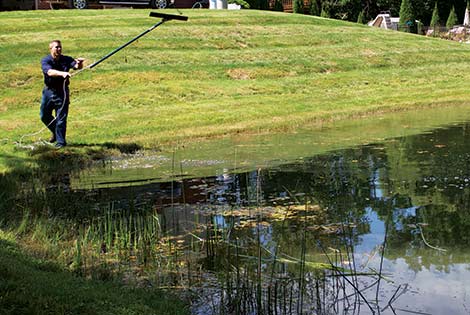Every pond owner will have to deal with algae or weed growth at some point in time, but treatment options will vary depending on the type of plant, size of treatment area, what the pond is used for and location.
Assess the Situation
Before getting started, identify what lives in your pond. Is it an algae, floating, submerged or emergent weed? Do most of the weeds grow on the surface of the water or below? To help identify your plant visit our Weed ID Guide.
Once you know what type of plant you are dealing with, measure the size of the area to be treated, this will help determine what product works best and how much you will need to use and if multiple treatments are required.
Next consider how the pond is used and where it is located, as some chemical treatments will have irrigation, livestock, swimming or state restrictions.
Another thing to consider outflow: if the pond has a natural outflow and won't hold a pond dye for very long, chances are any liquid chemicals that are applied to the water won't be able to make contact long enough for it to be effective.
Types of Treatment
There are two types of treatment used by pond owners to control algae and pond weeds: Chemical and Mechanical.
Chemical Control
Algaecides and herbicides are commonly used and sometimes the best option to regain control. Some pond weeds like duckweed and watermeal are almost impossible to skim and rake out of the pond because they are so tiny. Other weeds like cattails and bulrush can still be problematic after cutting because they will regrow from seeds and remaining rhizomes.
Both algaecides (used to treat forms of algae) and herbicides (treats pond weeds) can be found in either a liquid or granular form.
- Liquid applications are commonly used for floating weeds and algae that are sitting on the pond's surface (or up to 3 feet deep) and for emergent weeds that grow above the water along the shoreline. Use a pressurized sprayer and apply directly to the targeted plant or for submerged weeds place sprayer's tip beneath the water's surface and spray evenly.
- Granular applications are generally used in ponds, lakefronts or canals and target weeds in deeper water, beds or thick mats. Apply evenly and directly onto the target plant using a hand spread and boat if necessary.
Chemical Application Best Practices
Anytime you use chemicals to treat weeds or algae, you want to keep the following in mind:
- The best time to apply chemicals is in the morning on a sunny, low wind day to reduce possible chemical drift and take advantage of the plant's ability to metabolize the chemical effectively.
- Consider adding a surfactant like Airmax Treatment Booster Plus to a liquid chemical to break water tension and allow the chemical to penetrate the target protective surface faster.
- Once summer temperatures rise and if the vegetation has taken over your pond, it is extremely risky to treat because of the likelihood of a fish kill due to low oxygen levels. If you have fish in your pond, we suggest treating in sections treat 1/4 – 1/2 of the pond at a time, while waiting 10-14 days between treatments.
- Wait until the target has turned browned and died before removing. Once the plant has died, remove as much of the dead debris with a pond tool before it turns into muck.
Mechanical Control
Pond skimmers and rakes with floats are best to rake or skim off floating weeds and algae from the surface of the water. A Weed Cutter and Weed Raker can remove emergent weeds like phragmites or the roots can be dug up, but it will regrow from seeds and remaining rhizomes. Submerged weeds can also be raked, however, if any fragments, roots or tubers are left in the pond they will reestablish so don't forget to treat the pond with pond dye and bacteria to reduce nutrients and excessive sunlight.
Last Updated: April 21, 2021


